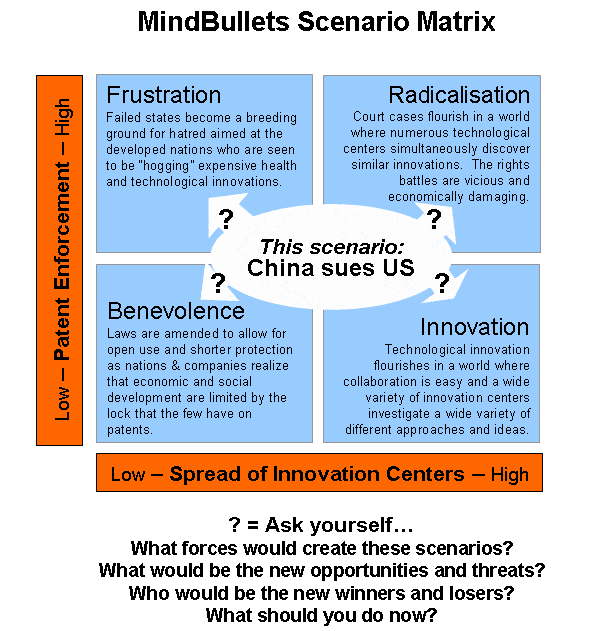CHINA SUES US FOR IP THEFT

US sued for compulsory licensing of revolutionary biotech treatment
- Dateline
- 8 August 2012
The WTO was in uproar today as China’s trade representative, Hu Way Lo, announced a suit against the US government. “We have been patient but the US has now licensed their own firms to produce patented biotechnology drugs owned by Chinese firms – this is unacceptable.”
During the outbreak of human-related bird flu in Florida last year 1,032 people died. The US immediately attempted to buy the Chinese medication Axxavac made by Sinovac. They were unable to produce sufficient doses. The US insisted that local firms be allowed to produce the drug and rushed a compulsory licensing law through congress.
Axxavac is one of a new range of sophisticated drugs developed from experiments with human stem cells. US scientists are now decades behind China after they banned such investigations. The Chinese feel that since the US voluntarily chose not to pursue this avenue they should not be allowed to benefit from the key learnings of others.
“When we were developing our own capacity and abilities the US government refused to allow developing countries to compulsorily license new drugs that would be of benefit to our people. They cannot now demand rights they wouldn’t give to others,” said Hu Way Lo in his statement at the WTO.
According to the US Secretary of State “It’s not the same thing. Our people are dying and we must have the cure – no matter what!”
ANALYSIS >> SYNTHESIS: How this scenario came to be
Background
Science and discovery are Darwinian in that only the best centers for innovation survive. The ingredients for good and expansive scientific research are eager research students, plenty of public money, and few political restrictions on what may be pursued. Many developed nations got a head start by ‘copying’ ideas from other countries – most notably the US in the 19th century and Japan after the World War II. For instance, US industrialization got going by ‘stealing’ the ideas from British factories – steam driven machines and the like; Japan likewise ‘stole’ concepts in electronics from the fledgling US semi-conductor industry. Russia, of course, stole the entire nuclear technology secrets from the US labs at Los Alamos.
As the US government discovers a penchant for tinkering with their education system and conservative elements start to limit the scope of discovery as well as who may do the discovering countries as diverse as India, Brazil, Singapore and China are attracting their graduates home to new centers for innovation.
It is likely that, as the ‘developing’ countries listed above become wealthier the US influence on research and development will begin to decline until the day that the US has to call on help from other, more developed, centers for excellence.
The real debate, though, is over the future of intellectual property protection. In the West patents are being used as a form of protectionism over the cheaper developing nations. Governments (especially in Japan, the US, and EU) are increasing the power that patent holders have – this despite the fact that all owe their prosperity to the ‘theft’ of patents. This has resulted in putting an artificial cap on development. Developing countries are choosing simply to opt out. However, what happens when it comes back to bite Western countries when developing countries produce something they may want? Do they break the very laws they set up?
Technological ‘theft’ has allowed the maintenance of a balance of power and a rapidly evolving and improving standard of living for everyone. A world in which technological developments are absolutely controlled is neither possible, nor desirable.
1999: TRIPS and the WTO
In 1990 Novopharm became one of the first companies to apply for a compulsory license of a patent owned by the pharmaceutical company Eli Lilly. A few short years later and the storm created by this reached the World Trade Organization (WTO) where the Trade Related Intellectual Property Rights Agreement (TRIPS) was amended. The provisions, signed in 1999, allow any person to apply to their patent authorities for a compulsory license to be given by the patent owner.
There are specific criteria and poor countries, for instance, may apply where drugs needed to treat endemic diseases are too expensive. Member states with generic pharmaceutical manufacturers are able to grant compulsory licenses, allowing those manufacturers to make medicines for export to any ‘least-developed’ country member of WTO and to other member countries that have notified the WTO of an intention to use the system as an importer.
Indian manufacturers promptly give notice that they wish to produce generic versions of popular (and expensive) anti-retroviral drugs used as part of HIV / AIDS drug cocktails.
2001: South Africa and Big-Pharma
Forty drug companies band together to sue the South African government after it announces that it wishes to compulsorily license AIDS drugs and import them. The exercise is a public relations disaster for the firms as they are portrayed as money hungry monsters murdering sick poor people. They back down.
After the September 11 attack in the US, the US government issues an order for the compulsory licensing of Cipro, an antidote for anthrax, for fear that an insufficient number of doses would be available in case of further terrorist attacks. The big pharmaceutical companies back down and shift their research to life-style diseases (such as impotence) that are unlikely to be accepted for compulsory licensing.
2002: US Education Climax
Legislation enacted in the US after September 11 begins to affect the number of foreign students able to seek visas for entrance. The 548,000 foreign students in America in the academic year 2000/01 contributed US$ 11 billion to the US economy, through fees, living expenses and the like. Higher education is the fifth-largest service-sector ‘export’, according to data from the Department of Commerce. Most foreign students come from Asia – China, India and Japan predominantly – and their participation in American education and research is acknowledged as vital, particularly in the fields of mathematics, computer science, engineering and technology. Without these students, research that keeps the United States at the scientific and technological edge would flounder. Declines in the number of American high school and college students choosing engineering and physical science have been made up during the past several decades by increases in foreign-student enrollment at the graduate and post-graduate levels. In the past, most stayed on to participate in the US economy and many of those that went home took American attitudes and values with them. This has been an important influence on America’s links with other countries. Returning students have also often retained links with classmates in the United States, giving Americans invaluable contacts abroad.
A further threat to the quality of US education is the rise of pressure on schools to teach ‘intelligent design’. Intelligent design, a concept some scholars have advanced over the past 15 years, holds that Charles Darwin’s theory of natural selection causing gradual changes over time cannot fully explain the origin of life or the emergence of highly complex life forms. It implies that life on earth was the product of an unidentified intelligent force.
The number of US school leavers seeking graduate study positions in science starts to sag.
2005: China: Center For Innovation
“The United States has failed to adequately finance scientific research and isn’t producing the numbers of engineers, computer scientists and physicists the country needs,” David R. Goode, CEO of the Norfolk Southern Corp, told a luncheon gathering of the World Affairs Council of Greater Hampton Roads.
Between 2000 and 2005, China invested 5 billion Yuan in research and development. As a result, reckons the Boston Consulting Group, biotechnology is flowering in 300 publicly funded laboratories and around 50 start-up companies, mainly in and around Beijing, Shanghai and Shenzhen. The science ministry claims that as many as 20,000 researchers work in the life sciences in China.
This is tiny compared with the US$ 15.7 billion invested in research and development last year alone by America’s biotechnology industry, which employs 191,000 people. But the speed with which China’s industry is growing provokes both wonder and anxiety in the outside world. Some worry that a lack of public debate over biotechnology, and different philosophical traditions, mean that China will head off in directions that are morally unacceptable in the West.
Close to the end of his term, George W Bush signs into law a bill that bans all research into stem cells. Scientists queue up to leave for China where stem cell research is being encouraged.
2007: Outbreak: Swine Flu
The Chinese government, embarrassed by an outbreak of Severe Acute Respiratory Syndrome (SARS) in 2003 is quick to announce that a version of swine flu has crossed the species barrier from pigs to humans in June 2007.
They act fast; within a month the virus has been isolated and genetically sequenced. Then, in a major coup for Chinese medical researchers, they release a fast-acting anti-viral cure for the disease. The small research group at the University of Shanghai that produced the drug is spun off and set up as a private company: Sinovac.
Sinovac rapidly becomes expert at producing drugs for diseases found predominantly in developing countries. By the end of 2008 the company is worth US$ 2 billion.
2012: A Global Storm
Global Warming is back on the agenda after freak storms across the US and Mexico trigger severe flooding not seen since Hurricane Katrina devastated parts of the US in 2005.
Tropical diseases, never seen before in the US, are rampant in the aftermath of the recovery and conditions are perfect for an outbreak of human-related bird flu. An especially pernicious strain is discovered to be behind the deaths of 500 people during the clean up operations.
As the number of deaths climbs to 1,000 the US president announces to congress that a state of emergency exists.
The US Health Secretariat ‘discovers’ the work done by Sinovac to combat a similar outbreak in Angola in 2009 and requests assistance. Sinovac has committed to producing a million doses of a new AIDS vaccine for the Indian government and is unable to assist. The US State Department declares that it will start to purchase generic versions from local companies under compulsory licensing laws.
When the Chinese government refuses to accept this US act at the WTO the US government dispatches an undisclosed number of nuclear submarines and aircraft carriers to international waters off the China coast.
Negotiations start and the Chinese demand the rights to numerous US-owned patents in exchange. The entire foundation of patent law comes under review.

Links to related stories
- MindBullet: BIRD FLU PLAGUE ON ITS WAY TO USA AND EUROPE (Dateline: 25 April 2009, Published: 24 February 2005)
- MindBullet: CHINA'S ATTITUDE TO IP BECOMES WORLD NORM (Dateline: 12 September 2015, Published: 01 December 2005)
- Patent fights rumble in China - [email protected]
- The Patent and Trademark Laws in China - Zehui “Bradley” Yu, Esq. Managing Partner, Unitalen Law Office
- China's Sinovac Biotech authorised to trial bird flu vaccine - Forbes, 24 November 2005
- Drugs list set to be overhauled, bhuma shrivastava - Business Standard, New Delhi, 26 August 2005
- Biotech's Yin and Yang - The Economist, 12 December 2002
- Prescription for change - The Economist, 16 June 2005
- US plan assumes worst for bird flu - Reuters, 6 December 2005
Warning: Hazardous thinking at work
Despite appearances to the contrary, Futureworld cannot and does not predict the future. Our Mindbullets scenarios are fictitious and designed purely to explore possible futures, challenge and stimulate strategic thinking. Use these at your own risk. Any reference to actual people, entities or events is entirely allegorical. Copyright Futureworld International Limited. Reproduction or distribution permitted only with recognition of Copyright and the inclusion of this disclaimer.